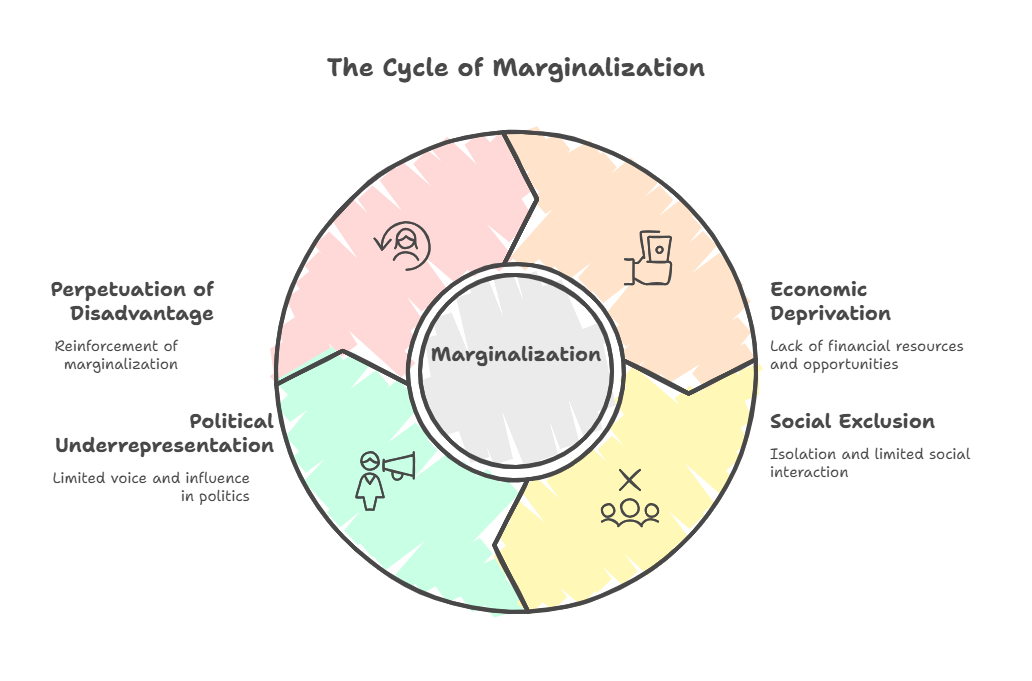- Filter By :
- Geography
- History
- Indian Heritage & Culture
- Indian Society
-
Q. "Marginalized communities in India face layered vulnerabilities that go beyond economic deprivation." Analyze with examples. (150 words)
21 Jul, 2025 GS Paper 1 Indian SocietyApproach:
- Introduce the answer by briefing about layered vulnerability of marginalised in India
- Delve into different Dimensions of Layered Vulnerabilities in India
- Suggest Measures to Mainstream Marginalized Communities
- Conclude suitably.
Introduction
The recent challenges faced by transgender persons in digital access, recent evictions of tribes from Nagarhole Tiger Reserve, and the disproportionate impact of natural disasters on coastal fisherfolk demonstrate that marginalized communities in India confront multi-layered vulnerabilities — rooted not just in poverty, but also in identity, geography, social stigma, legal invisibility, digital backwardness and institutional neglect.
Body:
Dimensions of Layered Vulnerabilities in India
- Social Hierarchies and Caste-Based Exclusion
- Dalits and Adivasis still face untouchability, landlessness, and discrimination despite affirmative action.
- Example: Manual scavenging is predominantly practiced by Dalits despite being legally banned (Prohibition of Employment as Manual Scavengers Act, 2013).
- Gender and Intersectionality
- Women from marginalized communities (e.g., Dalit, tribal women) face multiple layers of disadvantage—patriarchy, caste, poverty.
- SC/ST women have higher maternal mortality rates and lower access to institutional delivery.
- Women from marginalized communities (e.g., Dalit, tribal women) face multiple layers of disadvantage—patriarchy, caste, poverty.
- Political and Institutional Marginalization
- Many groups remain underrepresented in political institutions, limiting their voice in policy-making.
- Example: Transgender and tribal persons are rarely seen in legislatures despite legal provisions.
- Also, despite the Transgender Persons (Protection of Rights) Act, 2019, transgender individuals struggle with access to housing, employment, and healthcare.
- Geographical and Environmental Exclusion
- Fisherfolk, forest dwellers, and urban slum dwellers often lack formal land titles, affecting access to welfare and security.
- Coastal Regulation Zone (CRZ) violations lead to eviction of fishing communities without adequate rehabilitation.
- Fisherfolk, forest dwellers, and urban slum dwellers often lack formal land titles, affecting access to welfare and security.
- Digital Divide and Educational Inequality
- Digital illiteracy excludes marginalized communities from education, employment, and e-governance services.
- NSSO (National Sample Survey Office) data reveals a staggering disparity, only 24% of rural households have internet access.
- Digital illiteracy excludes marginalized communities from education, employment, and e-governance services.
Measures to Mainstream Marginalized Communities
- Strengthen Identity and Legal Recognition
- Universal Social Registry: Build a digitally inclusive database (with offline options) to ensure that marginalized persons, including nomadic tribes, transgender individuals, and urban poor, are not excluded due to lack of documents.
- Legal Aid Clinics in Marginalized Areas: As per Article 39A, expand free legal aid to ensure access to justice in SC/ST-dominated villages and slums.
- Inclusive Education Reforms
- Bridge Curriculum for First-Generation Learners: Tailored programs to ease the transition into mainstream schooling for children from marginalized backgrounds (e.g., tribal areas, minority-dominated pockets).
- Representation in Curriculum: Integrate contributions of Dalit, tribal, and minority leaders (e.g., Savitribai Phule, Birsa Munda) into textbooks to promote dignity and identity.
- Economic Empowerment Beyond Quotas
- Community-Owned Enterprises: Encourage tribal, Dalit, and minority cooperatives through subsidized loans, skill training, and market linkages (e.g., tribal honey collectives, Dalit food startups).
- Social Procurement Policy: Reserve a percentage of government procurement from enterprises led by SC/ST, PwDs, transgender persons, and women’s SHGs.
- Gendered and Intersectional Welfare Schemes
- Intersectional Budgeting: Extend Gender Budgeting into Caste-Sensitive and Disability-Sensitive Budgeting with clear allocations in health, housing, education, etc.
- Accessible Infrastructure and Public Services
- Design for All Mandate: Enforce universal accessibility standards in all public infrastructure under a time-bound “Accessible Bharat 2.0” mission.
- Monitoring and Accountability
- Social Inclusion Audit: Like social audits in MGNREGA, conduct third-party audits of inclusion across flagship schemes.
- Real-Time Disaggregated Data Dashboards: Publish community-wise outcomes (education, employment, health) to track progress and identify gaps.
Conclusion
“Injustice anywhere is a threat to justice everywhere.”-Martin Luther King Jr. Mainstreaming marginalized communities in India requires targeted, inclusive, and data-driven interventions, guided by empathy, representation, and constitutional morality. Only then can India fulfill the promise of “Sabka Saath, Sabka Vikas” with Sabka Vishwas and Sabka Prayas.”
To get PDF version, Please click on "Print PDF" button.
Print PDF





